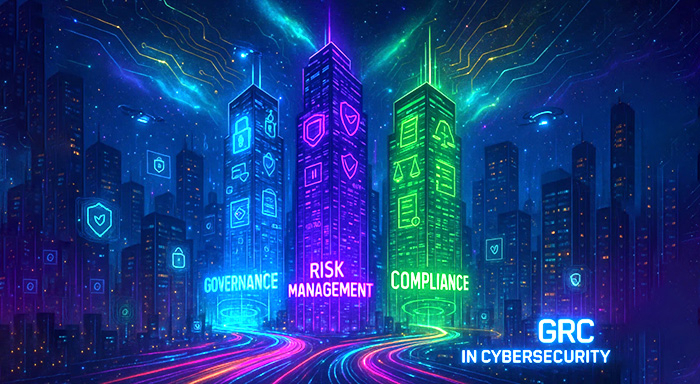In an era where cyber threats are increasing promptly, protecting sensitive customer data while adhering to regulatory compliance is often a challenging task for businesses. That's precisely where GRC in cybersecurity has been gaining traction. GRC, also abbreviated as Governance, Risk, and Compliance, is an organizational tactic that creates a powerful security infrastructure for modern organizations. Think of it as a set of security practices that protect your business against vulnerable threats but also ensure meeting compliance requirements.
OCEG (Open Compliance and Ethics Group)—a nonprofit organization introduces this idea in 2007. The aim was to minimize security risks, lower costs, reduce irregularities, and boost decision making. With robust innovation and technology adoption, they integrate various tools and software that help manage governance and risk management. This makes it essential for businesses across every level to use GRC to achieve goals, measuring risks, bookkeeping, and even financial reporting.
For startups and small-scale businesses, considering structured, scalable security practices and best tips for cybersecurity for small businesses can help you create a robust GRC framework. However, this post walks you through core elements, GRC tools, essential benefits, and its importance that help you know everything about what GRC in cybersecurity is.
Understand GRC in Cybersecurity
GRC contains three pillars—Governance, risks management, and compliance. It’s a strategic technique that helps organizations align their IT activities with business requirements while meeting regulatory compliance. Implementing GRC in cybersecurity practices ensures minimal wastage, increased efficiency, and reduced noncompliance challenges. However, security is not just an independent practice; it offers visibility, accountability, and reliability across the overall business environment. To understand GRC and essential cybersecurity trends, it’s crucial to know essential components that help control and manage overall governance, potential risks, and industry standards.
Components of GRC in Security landscape
Governance:
Governance in GRC refers to a suite of security policies, principles, and framework that help businesses achieve their goals. It represents the responsibilities of main stakeholders from employees to managers or directors and the right guidelines of what their specific role is in protecting digital assets. Good governance fosters your team to follow the organization’s basic and social responsibility policies like ethics, resource management, accountability, and transparency in data sharing.
Risk Management:
Similar to legal, financial, and security risks, businesses often experience many cyber risks like ransomware, phishing, and data breaches. This GRC risk management helps you detect and prevent these risks, allowing you to respond quickly to cyberattacks. Businesses leverage this robust GRC in cybersecurity practice to predict potential technical risks to reduce loss, increase efficiency, and safeguard reputation.
Compliance:
Compliance refers to an act that combines regulatory laws, rules, and industry standards, ensuring your organization meets necessary guidelines. With the growing cyberattacks, these security protocols are becoming hard rapidly like GDPR, SOX, HIPPA, and PCI-DSS. Proper adherence to compliance helps the organization meet legal obligations, while eliminating unnecessary costs, and avoiding penalties.
However, each component has its own specific role in running a business, but they also produce some limitations that create security gaps in organization's operations. The GRC strategy combines these components into one cohesive place to create a powerful framework. This allows businesses to grow promptly without hindering government and industry regulations. In addition, this also helps establish trust with customers, employees, and stakeholders, ensuring their sensitive data is protected.
Why is GRC Crucial?
In our digitally interconnected world, the number of cyber threats is increasing rapidly through weak encryption protocols and lack of compliance education. Implementing a good GRC framework offers an effective strategy that helps manage these challenges and maintain customer trust intent. Organizations that leverage GRC in cybersecurity practices may see significant benefits, includes:
Improved Decision Making:
GRC implementation, real-time resource monitoring, and early risk detection gives you complete control by offering instant data insights. This detailed analysis helps you make informed decisions instantly before things get worse.
Cost-effective:
Robust GRC strategy removes redundant processes, identifies overlaps in compliance which can lead to saving time and money. Early risk detection and robust security practices can help minimize unnecessary costs and opens new opportunities for security investment.
Boost Persistency:
An integrated GRC in cybersecurity framework makes your organization capable of handling and mitigating potential disruptions and cyberattacks. By creating an efficient, well compliant, and more resilient structure, organizations can lead to long-term success and growth.
Strong Security Practices:
Implementing governance, risk management, and compliance aligns to a robust security environment and significantly minimizes the risk of data thefts. These key tactics help you protect business operations, improve efficiency, and sensitive customer information.
Quick Compliance Traits:
Moreover, regular audits are simple and quick if policies, rules, processes, and documentation align with a centralized location. Following industry standards and government regulations mitigates potential risks, financial losses, and significant reputation harm.
The Role of GRC Tools in Cybersecurity
With the increasing risks of cyberattacks, many organizations shift traditional strategies to advanced GRC software to manage and automate operational tasks. GRC plays a crucial role in implementing cybersecurity practices, offering a strategic approach that facilitates the entire regulatory compliance process. They automate repetitive tasks, simplify complex processes, and align security practices to fetch IT operations with business goals. With a wide range of benefits, the following are the common benefits that can be seen after implementing GRC in cybersecurity practices:
- Early risks detection and prevention
- Policy and compliance management
- Incident response monitoring
- Audit assessment and review
- Stakeholder risks management
But what are the popular GRC tools in cybersecurity involves platforms like RSA Archer, MetricStream, ServiceNow GRC, LogicGate, and more. They provide a comprehensive dashboard where stakeholders can get a detailed view of their business performance and interact across departments.
Conclusion:
Knowing what GRC in cybersecurity is, the initial step for organizations seeking to protect their digital assets and implementing compliance regulations is important. Regardless of whether you are a CISO, business owner, or a casual cybersecurity learner, adopting this sophisticated strategy can transform the way you approach digital risks. By implementing all three pillars—governance, risks management, and compliance into their security strategy, organizations can manage and secure their operations effectively. Despite its vast advantages, many organizations hesitate to adopt GRC in cybersecurity practices, thinking cybersecurity is technical and more complex.
So, is cybersecurity hard to implement? If you are often asking yourself this question, do not worry. Starting the journey with robust practices like GCR helps you streamline the process. More than just detecting and mitigating cyber threats, these strategies also enhance efficiency, productivity, and resilience.


